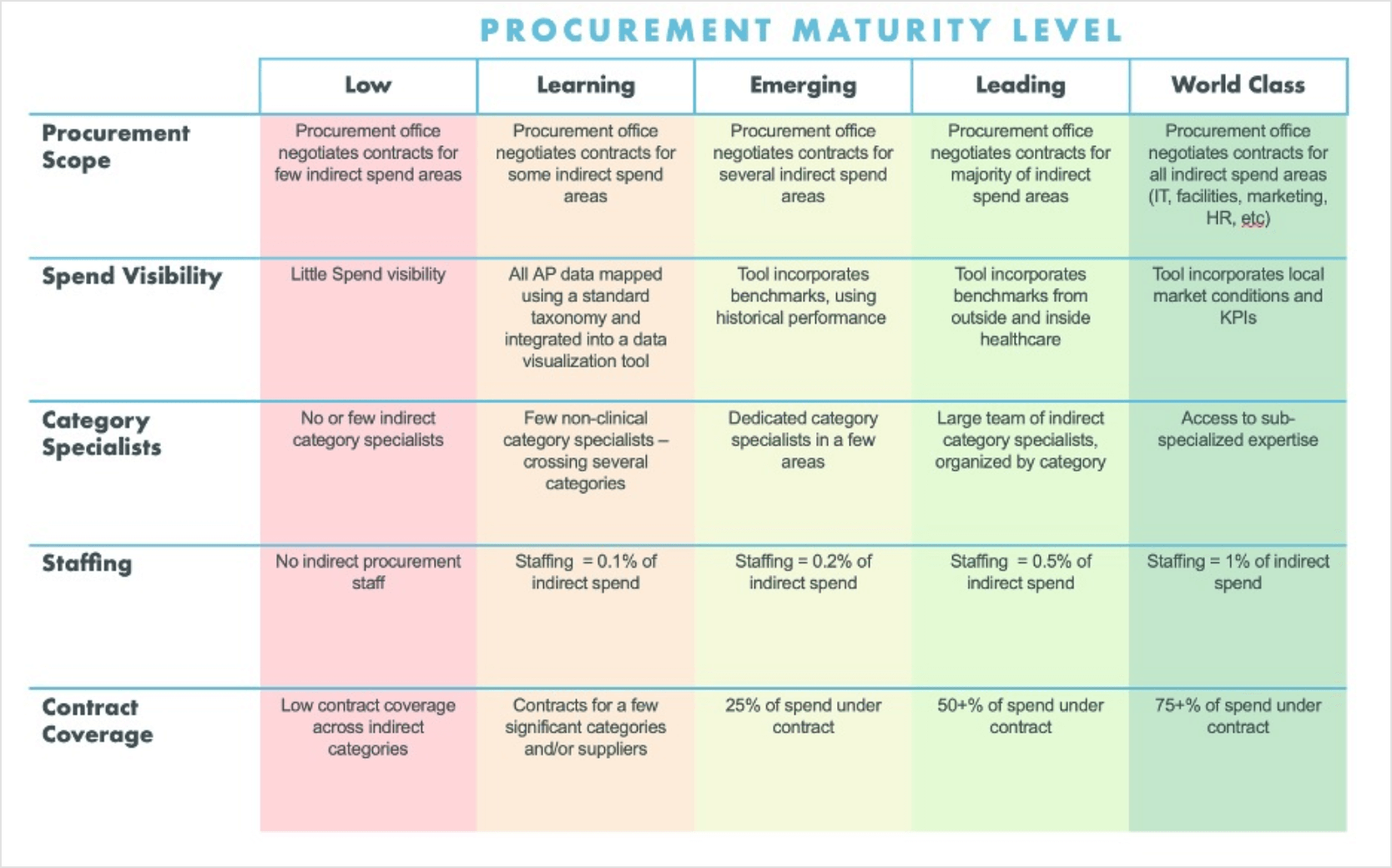

Unlocking Hidden Value:
Navigating Healthcare
Procurement Maturity
The Procurement Maturity Model is more than just a self-
assessment tool; it’s an invitation to transform.
This article was originally published in MedCity News.
In today’s complex healthcare landscape, Chief Financial Officers (CFOs) face constant pressure to optimize resources and maximize value. While clinical excellence is still paramount, a strategic focus on indirect procurement emerges as a powerful, often overlooked, lever for achieving both. Indirect procurement encompasses everything from employee benefits and IT services to design and construction costs, facilities management, and professional services, representing a significant, yet often unseen, portion of healthcare spending.
Navigating this complex and multifaceted domain can take time and effort. Enter the Procurement Maturity Model; a self-assessment tool designed to empower healthcare CFOs and procurement leaders to unlock hidden value within their organizations. Further, partnering with an indirect procurement utility with deep category expertise and a real-time contracting data repository can turbocharge savings realization.
Understanding the Procurement Maturity Model
The Procurement Maturity Model is a valuable tool designed as a self-assessment for health systems to gauge their performance in indirect spend management. This multi-faceted model, born out of our collective experience spanning decades and a deep understanding of healthcare procurement’s nuances, offers a dynamic yet structured framework for health systems to self-grade their procurement capabilities and identify areas for improvement.
Beyond cost-cutting: A holistic approach to value creation
The Procurement Maturity Model transcends traditional cost-cutting measures. Instead, it encourages a holistic approach that delves into the nuances of indirect procurement, highlighting the potential for:
- Reduced costs: Optimize spend through strategic sourcing, negotiation, and contract management, eliminating waste and uncovering hidden cost-saving opportunities.
- Enhanced operational efficiency: Streamline processes, improve resource allocation, and gain visibility into indirect spending, increasing agility and responsiveness.
- Improved patient care: Free up valuable resources by optimizing indirect spending, allowing for greater investment in direct patient care and innovative technologies.
- Financial sustainability: Secure long-term financial health by bolstering operational efficiency and cost management, enabling better weatherproofing against market fluctuations.
Navigating the maturity journey: A five-stage framework
The Procurement Maturity Model is structured as a simple matrix, categorizing procurement capabilities, such as procurement scope, spend visibility, category expertise, talent, and contract coverage, across varying maturity levels—from foundational learning stages to pinnacle world-class practices. This framework enables healthcare leaders to discern their current standing within the procurement maturity spectrum and devise strategic plans for progression. The Procurement Maturity Model emphasizes the importance of self-diagnosis in understanding where an organization stands and where it needs to go, fostering a growth mindset rather than complacency.
Within the Procurement Maturity Model, organizations can dynamically assess and scale the current scale of operation and the strategic focus areas needed to support their organization toward the highest possible level of maturity. Examples of maturity levels reflect the following experiences and performance:
- Low procurement maturity: Organizations at this level often neglect the opportunities for non-clinical supply chain cost reductions. They negotiate contracts for a few indirect spend areas, with minimal spend visibility and staffing. Such organizations are highly susceptible to rising expenses and sub-par pricing and may find themselves operating at a loss.
- Learning procurement maturity: At this level of maturity, organizations are beginning to recognize the importance of non-clinical spend procurement. They negotiate contracts for some indirect spending areas and utilize data visualization tools, all with minimal staffing. However, there is a considerable learning curve still ahead.
- Emerging procurement maturity: Within this level, organizations negotiate contracts for several indirect spend areas, demonstrating increased spend visibility and dedicated category specialists. Staffing and contract coverage show improvement, marking considerable progress toward procurement maturity.
- Leading procurement maturity: Organizations at this level harness operational expertise within their procurement department or by using third-party experts to negotiate contracts for all indirect spending areas. They have advanced spend visibility tools, access to specialized expertise, and significant staffing, resulting in a high percentage of spend under contract.
- World class procurement maturity: At the pinnacle of procurement maturity, organizations harness the full power of non-clinical spending, either within their operations or often by using external procurement and supply chain experts. Here, they can negotiate contracts for all indirect expenditures, have advanced spend visibility tools, access specialized expertise, and utilize significant staffing, resulting in a high percentage of spend under contract.

Crucially, the Procurement Maturity Model encourages a customized approach. You don’t have to strive for world-class status in every category. Instead, use the model to prioritize based on your unique needs and goals strategically. Use the accompanying visual to pinpoint your organization’s current position and chart a course for sustainable progress.
Getting it done: Build or buy?
Establishing a robust indirect procurement function requires not only a substantial commitment of time and resources, but it also demands a firm commitment from the highest levels of leadership within the organization. This commitment is especially critical from key figures such as the Chief Operating Officer and Chief Financial Officer.
The journey towards procurement excellence requires a nuanced approach to managing long-standing relationships with preferred vendor partners, often kept by CIOs, CHROs, and VPs of support services. To ensure success without compromising on strategy, content, or control over qualifications, it is essential that these senior leaders proactively involve procurement professionals at the initial stages of sourcing, contract negotiation, and procurement processes. Only through such a collaborative and strategic approach can the organization hope to achieve optimal outcomes.
Often, health system leaders will only delegate decision-making when there is a strong and consistent directive from senior leadership. Their reluctance often stems from concerns — some valid, others less so — regarding the procurement team’s understanding of the specific needs of their functional area and the unique aspects of the products and services being procured. Consequently, business owners may limit the involvement of the procurement office to essentially cleaning up after the vendor partner has been chosen and the critical terms have been established by them.
Determining whether to build this robust indirect procurement function or partner with an outside firm presents a significant challenge. In healthcare, organizations tend to favor the “build” approach despite only a handful of organizations notably thriving by adopting a parochial strategy. Achieving success in this area demands not just time, but also a substantial commitment of resources, which few healthcare organizations have the patience and resources committed to meet these requirements.
Requirements of a robust indirect procurement function include:
- Specialized knowledge: Rely on the expertise of category-specific professionals to gain valuable insights and best practices. Imagine tapping into deep category expertise – specialists who negotiate exclusively within a specific indirect category – assuring the best negotiating influence possible.
- Industry benchmarks: Access valuable benchmarking data to compare performance and identify areas for improvement. Unlike direct supplies, indirect procurement doesn’t lend itself to SKU-based benchmarking. Further, these products and services aren’t unique to healthcare – retail companies, for example, procure the same goods and services. A robust indirect procurement benchmarking process must account for the nature of service-based contracts and encompass benchmark data outside of healthcare.
- Cutting-edge technology: Utilize advanced data analytics and automation tools to streamline processes and optimize spend. Most ERPs are built to manage SKU-based procurement and fail miserably when used to manage service-based contracts and purchases. Further, few offer the necessary capability to manage sourcing events and measure savings realization effectively.
- Continuous improvement: Indirect procurement is dynamic, with best practices and pricing changing rapidly. The ability to benchmark efforts against what dozens of other companies have achieved in the past few months rather than relying on stale data that could be dated by a year or more can be significantly constructive.
Health systems, ranging from the largest IDNs and academic medical centers to rural community hospitals, have advanced supply chain and procurement strategies since they were sequestered in the hospital basements. Today, leaders in these areas often sit at the executive table, influencing important strategies and difficult conversations about physician preference items.
Despite marked progress in the procurement function over the years, procurement’s influence hasn’t extended to non-clinical spending. Using the Procurement Maturity Model, state-of-the-art health systems predominate in the Learning or Emerging stages of development, with the lowest scores across staffing, use of indirect category specialists, and benchmarking outside of healthcare.
Applying the Procurement Maturity Model: A world-class use case
Cleveland Clinic stands ahead of most health systems in clinical outcomes, research, as well as indirect procurement. Notably, Gartner has named Cleveland Clinic the best healthcare supply chain for three consecutive years, and assessed in the Procurement Maturity Model, the organization stands out with a Leading designation.
Cleveland Clinic does many things well, not the least of which is indirect procurement. A hallmark of its approach is a sizable investment in procurement specialists dedicated to specific indirect categories. Similarly, Cleveland Clinic operates at a world-class level in terms of staffing. Most health systems devote a few professionals to indirect procurement or have their staff split time between direct and indirect categories.
No healthcare organization exists in isolation. Strategic partnerships with an indirect procurement utility, with category experts, a real-time contract data repository, and robust technology built for indirect procurement can bridge the gap and drive significant value. External benchmarking is where the Clinic recognizes the value of a procurement partner, particularly a partner with access to data outside the healthcare industry. Indirect spending categories are not unique to healthcare, with most indirect products and services being procured by organizations across sectors from the same or similar suppliers.
Understanding what non-healthcare organizations spend for the same or similar products and services is vital to effective sourcing.
Investing in the future: A transformative opportunity
The Procurement Maturity Model is more than just a self-assessment tool; it’s an invitation to transform. By embracing its guidance, health system supply leaders can:
- Set achievable yet ambitious procurement goals.
- Implement strategic plans for sustainable improvement.
- Forge partnerships that boost your capabilities.
- Unlock the full potential of indirect procurement and drive lasting value for your organization.
Adopting the Procurement Maturity Model positions health systems to efficiently manage their indirect spending, enhance their operational effectiveness, and contribute to their overall success and performance.








